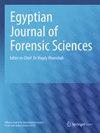Sex estimation based on glabella morphology in contemporary Brazilian human skulls
IF 1.3
Q3 MEDICINE, LEGAL
引用次数: 0
Abstract
Estimating sex from a dry skull depends on studying validated and specific traits. One such reference area exhibiting sexual dimorphism is the glabella, located on the frontal bone. This anatomical landmark is easily classified and shows promising results in sexual identification due to its magnitude variations between sexes. The present study is methodologically based on Walker’s approach, which visually analyzes cranial traits and scores them according to their morphology. This study aimed to investigate the sex estimation of dry skulls from Brazilian human skeletons for human identification through macroscopic analysis of the glabella. This analytical, quantitative, cross-sectional study utilized a sample of 471 skulls from both sexes, aged 25 years or older, belonging to the contemporary collection of the Center for Studies in Forensic Anthropology at the Faculty of Dentistry, University of Pernambuco (CEAF/FOP/UPE), Brazil. Data were recorded in an Excel spreadsheet and subsequently subjected to statistical analysis using IBM© SPSS (version 22.0). Initial observation of the skeletons excluded 52 (11.0%) due to age below 25 years, absence of a skull, or compromised glabella region, resulting in a final sample of 419 skulls. The mean age was 66.6 years, with a median of 67, a minimum of 25, and a maximum of 109 years. Regarding glabella types, score 2 showed the highest frequency (35.6%), while score 5 had the lowest percentage (7.9%). A statistically significant association was found between female sex and glabella scores 1 and 2. Also, individuals aged over 60 presented more glabella scores 1 and 2. The sex estimation accuracy for the sample was 76.1%, with females having a higher percentage of correct observations than males. The morphology of the glabella provides useful information for estimating sex in the biological profile. However, further studies on this morphological trait in other Brazilian osteological collections are encouraged to establish a national profile and contribute to human identification procedures in the country.根据当代巴西人类头骨的睑板形态推测性别
从干燥的头骨中估计性别取决于对有效和特定特征的研究。位于额骨上的帽状腱膜就是一个表现出性别二态性的参考区域。这个解剖学标志很容易分类,而且由于其在不同性别之间的幅度变化,在性别鉴定方面显示出良好的效果。本研究在方法上基于沃克方法,即通过视觉分析颅骨特征,并根据其形态进行评分。本研究旨在通过对头盖骨的宏观分析,研究巴西人类骨骼中干燥头盖骨的性别估计,以进行人类鉴定。这项分析性、定量、横断面研究使用了巴西伯南布哥大学牙科学院法医人类学研究中心(CEAF/FOP/UPE)当代收藏的 471 个年龄在 25 岁或以上的男女头骨样本。数据记录在 Excel 电子表格中,随后使用 IBM© SPSS(22.0 版)进行统计分析。对骸骨的初步观察排除了 52 个(11.0%)因年龄低于 25 岁、没有头骨或头盖区受损的骸骨,最终样本为 419 个头骨。平均年龄为 66.6 岁,中位数为 67 岁,最小为 25 岁,最大为 109 岁。关于头盖骨类型,得分 2 的频率最高(35.6%),得分 5 的比例最低(7.9%)。在统计学上发现,女性性别与龟头瘤评分 1 和 2 之间存在明显的关联。此外,60 岁以上的人出现 1 分和 2 分的情况较多。样本的性别估计准确率为 76.1%,女性的正确率高于男性。唇盖的形态为生物特征中的性别估计提供了有用的信息。不过,我们鼓励对巴西其他骨质样本中的这一形态特征进行进一步研究,以建立一个全国性的档案,为巴西的人类识别程序做出贡献。
本文章由计算机程序翻译,如有差异,请以英文原文为准。
求助全文
约1分钟内获得全文
求助全文
来源期刊

Egyptian journal of forensic sciences
MEDICINE, LEGAL-
CiteScore
2.00
自引率
0.00%
发文量
51
审稿时长
17 weeks
期刊介绍:
Egyptian Journal of Forensic Sciences, the official publication of The International Association of Law and Forensic Sciences (IALFS), is an open access journal that publishes articles in the forensic sciences, pathology and clinical forensic medicine and its related specialities. The journal carries classic reviews, case studies, original research, hypotheses and learning points, offering critical analysis and scientific appraisal.
 求助内容:
求助内容: 应助结果提醒方式:
应助结果提醒方式:


